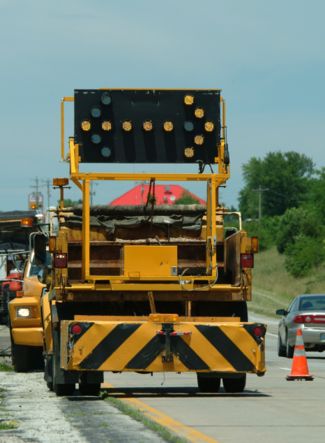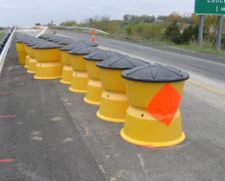Category:612 Impact Attenuators
This article presents two primary types of impact attenuators: truck-mounted attenuators and freestanding impact attenuators (sand barrels). Impact attenuators are designed to absorb energy of an impacting vehicle and reduce the force on a passenger to an acceptable level.
In addition to truck-mounted attenuators (TMAs), warning signs, revolving lights and flashing arrow panels are commonly used with mobile operations.
Contents
612.1 Truck-Mounted Attenuators
Truck-mounted attenuators (TMAs) are safety devices to be used for all mobile operations conducted near traffic. TMAs are energy-absorbing devices attached to the rear of the trucks used as protective vehicles, thus protecting the motorist and the protective vehicle's driver upon impact. Damaged TMAs are to be removed from service and either repaired or replaced.
The guidelines for the use of TMAs are in the table below:
Table 612.1 Use of TMAs
| Highway Type | Operation Location and Duration | ||
|---|---|---|---|
| In Lane | On Shoulder and Ramps and at Intersections | ||
| Mobile | Stationary | ||
| Two-lane Undivided | Recommended | Recommended | Recommended |
| Multi-Lane Undivided | Required | Recommended | Recommended |
| Multi-Lane Divided | Required | Required | Recommended |
612.2 Sand-Filled Impact Attenuators (Sand Barrels)
This system consists of a group of freestanding plastic barrels configured in increasing weights from the impact point toward the object. Such an array transfers the vehicle’s momentum to the increasing masses of sand in the barrels and provides a gradual deceleration. Each barrel is designed with a specific weight of sand to absorb the energy of an errant vehicle. Sand barrels are the preferred crash cushions for concrete traffic barrier, and are used when sufficient width is available for their placement. Refer to Standard Plan 612.20 for details. When specified, quantities are calculated and shown on the plans. No direct payment is made for the Type 1 object marker on the lead module. An estimate for replacement barrels needs to be included as a separate pay item, typically calculated as one for every ten barrels.
Sand barrels are most often used to shield fixed objects that cannot be removed or relocated. Sand barrels are recommended for temporary usage such as in work zones. A benefit/cost analysis is to be conducted before sand barrels are used in a permanent application.
An approved sand-filled impact attenuator may be installed on the exposed end of the barrier where the posted speed prior to construction on an existing facility or the anticipated posted speed of a temporary facility is greater than 35 mph. A crash cushion will be required on the upstream end for divided facilities, and on both ends for all two-way facilities. (Crash cushions are discussed in 616.6, Lighting Devices. Applicable pay items are included in the plans.
Proprietary Crash Cushions are alternate crash cushions that may be used when sufficient width is not available for sand barrels. These are typically used on the ends of temporary two-lane, two-way sections on divided highways. More information on proprietary crash cushions is available at 617.1.4 Crash Cushion.
612.3 Construction Inspection Guidelines for Sec 612
For Sec 612.2 Material. Certifications are to be collected on both the sand and retroreflective sheeting used in or on the sand-filled impact attenuators.
For Sec 612.3 Safety Requirements. The inspector is to request a copy of the manufacturer’s certification that states the units comply with the crash test requirements of NCHRP 350, Test Level 3, and have FHWA acceptance. This information is to be kept in the project files.
For Sec 612.4 Construction Requirements.
For Sec 612.4.1 Truck-Mounted Attenuator. TMAs are to be inspected to make sure they are structurally sound, the frames are not bent and that they appear to be in good working order. In some cases, the contractor may elect to add TMAs when TMAs are not required. Even elective TMAs need to be NCHRP 350 compliant so the certification still needs to be collected. Typically, TMAs are only required and paid for under conditions where the contractor is operating without a lane drop set up (cones, channelizers, etc.). TMAs that the contractor voluntarily adds to an operation are typically not paid for.
For Sec 612.4.2 Sand-Filled Impact Attenuator. The inspector is to request a copy of the manufacturer’s installation instructions for whatever particular brand of sand-filled impact attenuator the contractor is using. When inspecting the sand-filled impact attenuator arrays, make sure that the array is set up as shown in the standard plans and filled in accordance with the manufacturer’s recommendations. All lids are to be on and secured. MoDOT requires rock salt intermixed with the sand so that any water that gets into the barrels will not freeze and create a safety hazard. When checking the contents of the barrels, rock salt should be visible in the sand mix. During periods of extended cold weather, the sand should be checked periodically to make sure it hasn’t frozen because the salt content has been exhausted. If this condition is found, the contractor will need to add more salt or replace the sand/salt mixture.

